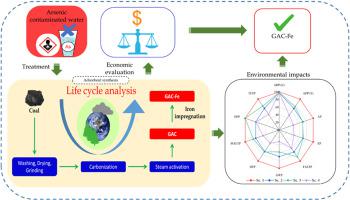Journal of Cleaner Production ( IF 9.7 ) Pub Date : 2023-10-30 , DOI: 10.1016/j.jclepro.2023.139557
Hemant Goyal , Tanishq Tyagi , Prasenjit Mondal

|
The potential health effects associated with consumption of arsenic contaminated water have motivated chemical and energy intensive treatment processes. Granulated activated carbon (GAC) and iron impregnated granular activated carbon (GAC-Fe) are the two adsorbents which have shown significant removal of arsenic (As(V)). However, the synthesis of different adsorbents involves significant different materials and energy interactions which have different environmental and economic burdens. This study evaluates and compares the environmental impacts arising from treatment of arsenic containing water using GAC and GAC-Fe adsorbents, for the selection of more suitable one. The life cycle inventory pertaining to treatment through two adsorbents was prepared based on the data available in literature. The impacts were assessed utilizing ‘Sphera LCA for experts’ software with three midpoint methods i.e. CML 2001, TRACI 2.1 and ReCiPe 2016. Results show that chemically treated/impregnated adsorbents for arsenic contaminated water treatment not only have lesser environmental emissions but also reduces the treatment cost. The treatment with GAC-Fe has ∼30% lower impacts in GWP, AP, EP, MAETP, FAETP, ODP, ADP (E) and HTP categories than treatment with GAC, since increase in adsorbent's specific uptake in GAC-Fe reduces the amount of total adsorbent requirement. GAC-Fe based water treatment costs ∼23% less than with GAC. The main responsible parameters for emissions are synthesis of GAC from hard coal precursor, and electricity consumption in carbonization and drying operations. Apart from this, in case of GAC-Fe, additional impregnation and drying operation also contributes to emissions. The utilization of coke oven gas generated in adsorbent synthesis for energy credits has potentially reduced the emissions and operating cost. The less standard deviation (<10%) in Monte Carlo (MC) uncertainty analysis, indicated the reliability and robustness of LCA impacts. This study exemplified the environment friendliness of metal impregnated GAC based arsenic contaminated water treatment.
中文翻译:

GAC和GAC-Fe吸附剂吸附去除地下水砷的生命周期分析和经济评价
与饮用砷污染水相关的潜在健康影响促进了化学和能源密集型处理工艺的发展。粒状活性炭 (GAC) 和铁浸渍粒状活性炭 (GAC-Fe) 是两种可显着去除砷 (As(V)) 的吸附剂。然而,不同吸附剂的合成涉及显着不同的材料和能量相互作用,从而具有不同的环境和经济负担。本研究评估并比较了使用GAC和GAC-Fe吸附剂处理含砷水所产生的环境影响,以选择更合适的吸附剂。与通过两种吸附剂进行处理有关的生命周期清单是根据文献中提供的数据准备的。利用“Sphera LCA for Experts”软件采用三种中点法(即 CML 2001、TRACI 2.1 和 ReCiPe 2016)对影响进行了评估。结果表明,用于砷污染水处理的化学处理/浸渍吸附剂不仅具有较少的环境排放,而且还减少了处理量成本。与 GAC 处理相比,GAC-Fe 处理对 GWP、AP、EP、MAETP、FAETP、ODP、ADP (E) 和 HTP 类别的影响降低约 30%,因为吸附剂对 GAC-Fe 的比吸收量增加会减少量吸附剂总需求量。基于 GAC-Fe 的水处理成本比 GAC 低约 23%。排放的主要参数是由硬煤前体合成活性炭以及碳化和干燥操作中的电力消耗。除此之外,对于 GAC-Fe,额外的浸渍和干燥操作也会导致排放。利用吸附剂合成过程中产生的焦炉煤气获得能源信用,有可能减少排放和运营成本。蒙特卡罗(MC)不确定性分析中较小的标准偏差(<10%)表明LCA影响的可靠性和稳健性。这项研究例证了基于金属浸渍活性炭的砷污染水处理的环境友好性。

































 京公网安备 11010802027423号
京公网安备 11010802027423号